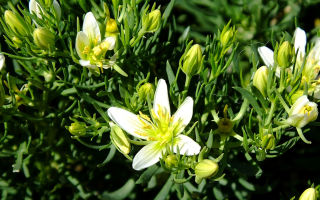Content
Traditional healers have long known the medicinal properties of harmala herb (burial ground). It is one of the most popular remedies used in ancient Eastern medicine. The useful properties of the burial ground were known more than 2.5 thousand years ago. The herb was used for diseases of the respiratory, genitourinary, nervous systems, and gastrointestinal tract.
What does the burial ground look like and where does it grow?
Harmala is a perennial plant. The grass grows up to 50 cm, but there are specimens up to 80 cm high. The root of the burial ground is powerful. It does not spread over the surface, but is directed vertically downward by 2-3 meters. The root reaches the aquifers of the soil.
The burial plant looks like a small bush. Its stems are naked, branched, green. The leaves are short-petiolate, divided into sharp lobes. The flowers of the harmala are large, white or yellow. They consist of 5 petals, the length of which is from 1.2 to 2.5 cm. The buds are located on short pedicels singly.
The burial ground begins to bloom in late spring or early summer. The seeds ripen in July-August.
Harmala grows on sandy, clayey and saline soils, steppes and semi-desert zones are suitable for it. You can meet the burial ground on pastures near wells, on wastelands, along roads, on rocky areas, on slopes.
Vast thickets are found in the southern part of the European regions of Russia, Mongolia, the countries of Central Asia, the Caucasus, Ukraine, and Western Siberia. Harmala is widespread in Dagestan, in the lowlands along the Caspian Sea.
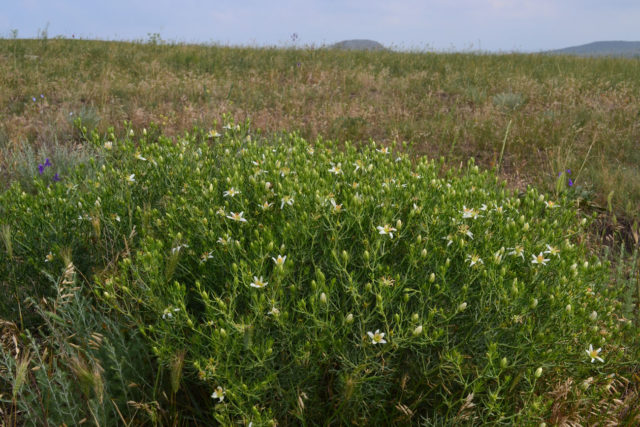
Chemical composition
Garmala contains a large number of nitrogenous compounds - alkaloids - derivatives of indole and quinazoline. They are distributed unevenly in parts of the plant:
- peganin accounts for up to 78% of the total number of alkaloids in the grass;
- up to 74% in the roots - harmine;
- 50-95% in seeds is harmaline.
We also managed to isolate organic compounds from harmala in pure form:
- harmalol;
- pegamine;
- deoxypeganine;
- peganol;
- peganidin;
- L-peganin (vazicin);
- acetylnorgarnine.
Young roots have 2 times more alkaloids than old ones. But the composition of the different parts of harmala varies depending on the place of growth. On average, the leaves contain from 1 to 5% of nitrogen-containing organic compounds, in the roots - 1.5-3.5%, in the flowers of the burial ground - up to 2-3%.
The burial ground contains:
- 24% protein;
- 31% extractives;
- 4% fatty oils.
The composition of the ground parts of harmala includes the following elements:
- magnesium;
- zinc;
- iron;
- potassium;
- strontium;
- aluminum;
- lead;
- nickel;
- chromium;
- manganese;
- copper.
The plant contains organic acids, saponins, carotenoids. The burial ground also contains vitamin C.
The healing properties of the herb burial
Harmala is recognized as a medicinal plant not only by traditional healers, but also by representatives of official medicine.The raw materials obtained from the burial ground are used in the production of drugs with anticholinesterase action. They are prescribed for lesions of the peripheral nervous system.
But the use of ordinary harmala in medicine is not widespread. The pharmaceutical industry produces more effective and less toxic products.
But this is not the only healing effect of the herb. In folk medicine, a burial ground is used as a remedy with the following properties:
- anticoagulant;
- antineoplastic;
- antibacterial;
- diaphoretic;
- antidiabetic;
- antiviral;
- pain reliever;
- choleretic;
- anti-inflammatory;
- antiparasitic;
- antidepressant;
- hypotensive;
- calming.
The substances contained in the burial ground reduce the oxidative stress of nerve tissues, improve cognitive abilities, and increase memory capacity. Under the action of the alkaloid harmine, the smooth muscles of the intestine, uterus, heart relax, peripheral vessels expand, and breathing becomes more frequent.
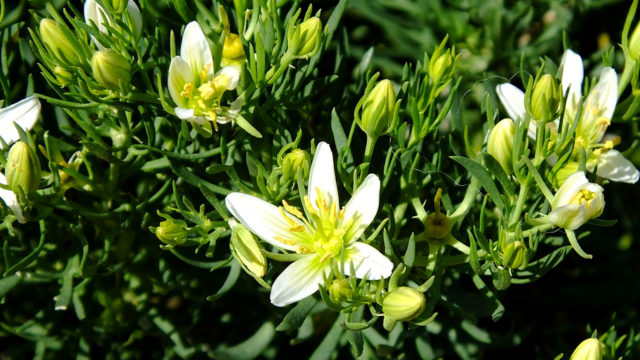
The use of harmala in traditional medicine
More than 2 millennia ago, the burial plant was used in Ancient Eastern medicine as a deodorant and sedative. Healers of that time believed that taking remedies based on harmala:
- increases the strength of the flesh;
- cleans the organs of the sternum from sticky moisture;
- drives urine, menstruation and breast milk;
- cleanses the body, removing black bile and thick phlegm during diarrhea.
The burial ground is no less popular in modern folk medicine. Healers can recommend using infusions, decoctions, baths with the addition of different parts of the plant. But more often it is used by people living in Central Asia.
In the countries of the East, rooms are fumigated with harmala for people who are sick and going on the road. It is believed that this can ward off troubles.
Infusions
Studies have shown that infusions prepared from the ground parts of harmala are characterized by anti-staphylococcal activity. The antibacterial effect is due to the inclusion of harmine, an alkaloid contained in the burial ground.
Burial infusions are recommended for:
- colds;
- febrile conditions;
- neurasthenia;
- epilepsy;
- syphilis;
- malaria;
- diseases of the gastrointestinal tract.
In some countries, infusions, decoctions of the burial ground are used as an abortifacient.
For the preparation of water infusion 1 tbsp. l. dried harmala leaves you need to pour 250 ml of boiling water, leave for 15 minutes. The filtered liquid is recommended to be taken in 2 tbsp. l. three times a day 20 minutes before meals.
In the same quantities, healers advise drinking the infusion of the burial ground for diseases of the digestive system, measles, and malaria. For problems with the gums and throat, the product is used to rinse the mouth.
Patients with myasthenia gravis, rheumatism are advised to consume infusion of harmala 10-50 ml 3 times a day, regardless of the time of meal. The volume of fluid should be increased gradually. Drinking the infusion is also recommended for patients who complain of painful urination.
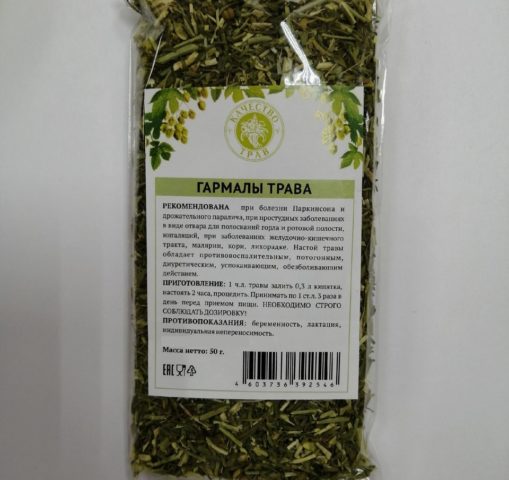
Tinctures
Traditional healers advise taking alcoholic tinctures of harmala for medicinal purposes. They are prescribed to patients who:
- syphilis;
- malaria;
- colds accompanied by fever;
- myasthenia gravis;
- paralysis;
- Parkinson's disease.
To prepare the tincture, you will need 100 g of harmala seeds. They should be poured into a glass container and pour 2 liters of dry red wine. Shake the liquid daily. After a month, you can start taking the product 25 drops 2-3 times a day on an empty stomach.
You can also make an alcoholic tincture from a burial ground. To prepare 10 g of herbs, pour 100 ml of medical alcohol. The liquid is left in a dark place, and after 3 weeks it is filtered. You need to take a remedy from harmala, 6-12 drops three times a day. They are diluted in 3-4 tbsp. l. clean water. The course of therapy lasts a month. After a 10-day break, it can be repeated.
Decoctions
Decoctions made from the ground parts of the burial herb are advised to patients under the following conditions:
- neurasthenia;
- epilepsy;
- disruption of the digestive system.
For the preparation of the broth 1 tsp. the dried grass of the burial ground is poured with a glass of boiling water and kept in a steam bath for 30 minutes. It should be used to rinse the mouth.
Decoctions are popular not only for the herbaceous part, but also for plant seeds. They are prescribed for asthma, shortness of breath, rheumatism. Healers advise to mix harmala and flax seeds in a 1: 3 ratio, take 1 tsp. mixture and pour 200 ml of boiling water. The broth is prepared under a lid in a water bath for 30 minutes. You need to drink the filtered product in 1 tbsp. l. half an hour before meals at least 3 times a day.
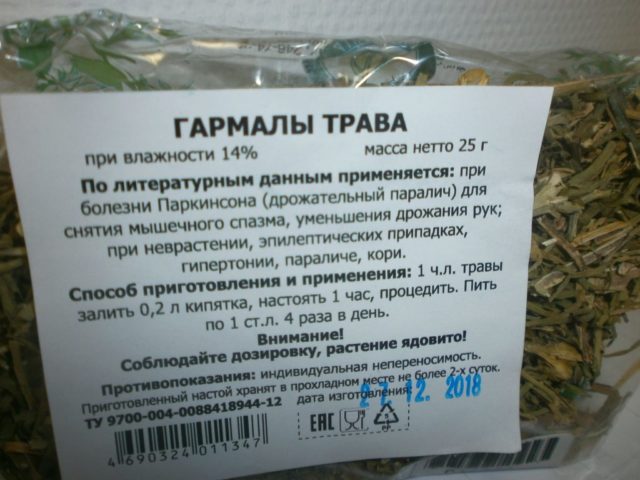
Oil
The harmala seeds contain about 14-16% fatty oil. It is 53% linoleic acid. It is used in paint and varnish production and soap making. Also, harmala essential oil is characterized by antibacterial action.
You can also prepare burial oil from grass. To do this, the ground parts of the plant are boiled in radish juice. Then the resulting liquid is mixed in a 1: 1 ratio with olive oil and boiled until the water has completely evaporated.
External use of harmala oil is recommended for therapeutic purposes for paralysis, numbness of the limbs. The tool is used in the treatment of external neuritis of the facial nerve.
Baths
Taking baths with the addition of a decoction of the burial ground is indicated for patients who:
- skin diseases caused by metabolic disorders;
- rheumatism;
- scabies.
You need to boil 100 g of dried harmala herb in 5 liters of water for 20 minutes. The remedy should be infused for at least 2 hours. Pour the filtered liquid into the bath. The recommended water temperature is + 35-40 ° С. Such baths should be taken for 15-20 minutes every other day.

Contraindications
Before using the funds from the burial ground, you should find out who can not. Do not forget that this herb belongs to poisonous plants.
The list of contraindications for harmala includes:
- hyperkinesis caused by overexcitation of the centers of movement in the cerebral cortex;
- pregnancy;
- lactation period.
Alkaloids in large quantities affect the psyche like drugs. When they enter the body at a dosage of more than 4 mg / kg of weight, the following side effects may develop:
- the appearance of hallucinations;
- lowering the temperature;
- the appearance of tonic and clonic seizures;
- violation of breathing until it stops completely.
With prolonged use of funds from the burial ground, disruption of the gastrointestinal tract, increased urination, and breathing problems are possible.
Harmala collection and preparation
For medicinal purposes, the ground parts of the plant are used. The burial ground is harvested during the period of budding and flowering. Herbalists pick off the branches, leaves and flowers of the harmala. Seed collection begins in the fall. It is necessary that they have time to fully mature.
On the same sites, you can collect a plant no more than once every 2 years.During this period, the burial ground has time to recover after cutting.
The collected raw materials are dried in well-ventilated rooms or in the open air. For this, the harvested grass of the burial ground is spread on a thick cloth or paper. The dried parts are cut into 8 cm pieces.
Store harmala in paper bags. It retains healing properties for no more than 2 years.
Conclusion
The medicinal properties of harmala herb should be used with caution, since it belongs to poisonous plants. For medicinal purposes, infusions, decoctions, and burial oil are used. They have antimicrobial, anti-inflammatory effects, have a positive effect on the nervous, digestive, and urinary systems.

